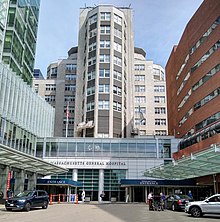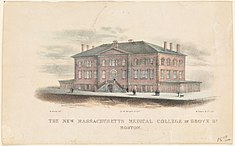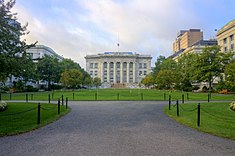Harvard School of Medicine
 | |
| Type | Private medical school |
|---|---|
| Established | September 19, 1782 |
Parent institution | Harvard University |
| Dean | George Q. Daley |
Academic staff | 11,694[1] |
| Students | Totals:
|
| Location | , , United States 42°20′13″N 71°06′14″W / 42.33694°N 71.10389°W |
| Website | hms |
 | |
Harvard Medical School (HMS) is the medical school of Harvard University and is located in the Longwood Medical Area in Boston, Massachusetts. Founded in 1782, HMS is one of the oldest medical schools in the United States,[2] and provides patient care, medical education, and research training through its 15 clinical affiliates and research institutes, including Massachusetts General Hospital (MGH), Boston Children's Hospital, Dana–Farber Cancer Institute, Brigham and Women's Hospital, Beth Israel Deaconess Medical Center, Mount Auburn Hospital, McLean Hospital, Cambridge Health Alliance, The Baker Center for Children and Families, Spaulding Rehabilitation Hospital, and others[3]
Harvard Medical School also partners with newer entities such as Harvard Catalyst, Broad Institute of MIT and Harvard, Harvard Stem Cell Institute, the Center for Primary Care, and Wyss Institute for Biologically Inspired Engineering.[3]
History
Harvard Medical School was founded on September 19, 1782, on the initiative of Harvard President Joseph Willard. The founding faculty were John Warren, Aaron Dexter, and Benjamin Waterhouse. It is the third-oldest medical school in the United States, after the Perelman School of Medicine at the University of Pennsylvania and Columbia University College of Physicians and Surgeons.
Lectures were first held in the basement of Harvard Hall, then in Holden Chapel. Students paid no tuition but purchased tickets to five or six daily lectures.[2][4] The first two students graduated in 1788.[2]
In the following century, the school moved locations several times due to changing clinical relationships, a function of the fact that Harvard Medical School does not directly own or operate a teaching hospital.[5] In 1810, the school moved to Boston at what is now downtown Washington Street. In 1816, the school was moved to Mason Street and was called the Massachusetts Medical College of Harvard University in recognition of a gift from the Great and General Court of Massachusetts. In 1847, the school was moved to Grove Street to be closer to Massachusetts General Hospital. In 1883, the school was relocated to Copley Square.[2] Before this move, Charles William Eliot became Harvard's president in 1869,[6] and found the medical school in the worst condition of any part of the university. He instituted drastic reforms that raised admissions standards, instituted a formal degree program, and defined HMS as a professional school within Harvard University that laid the groundwork for its transformation into one of the leading medical schools in the world.[4]
In 1906, the school moved to its present location in the Longwood Medical and Academic Area.[2][7]
Innovations
Harvard Medical School postdoctoral trainees and faculty have been associated with several important medical and public health innovations:[2]
- Introduction of smallpox vaccination to America
- Introduction of insulin to the US to treat diabetes
- Comprehending of the role of vitamin B12 in treating anemia
- Identification of coenzyme A and understanding of proteins
- Developing tissue culture methods for the polio virus, which paved the way for vaccines against polio
- Mapping the visual system of the brain
- Development of the first successful chemotherapy for childhood leukemia
- Development of the first implantable cardiac pacemaker
- Discovering the inheritance of immunity to infection
- Development of artificial skin for burn victims
- First successful heart valve surgery (at Peter Bent Brigham Hospital, 1923)[8]
- First successful human kidney transplant
- First reattachment of a severed human limb
- Discovery of the genes that cause Duchenne muscular dystrophy, Huntington's disease, amyotrophic lateral sclerosis (Lou Gehrig's disease), and Alzheimer's disease, among many others
- Establishing the importance of tumor vascular supply (angiogenesis) and seeding vascular biology

Broadening admissions
Women
In mid-1847, professor Walter Channing's proposal that women be admitted to lectures and examinations was rejected by the President and Fellows of Harvard College. That year Harriot Hunt became the first woman to apply to Harvard Medical School. Dr. Oliver Wendell Holmes Sr. had recently been made Dean of the school and initially considered accepting her application. He was heavily criticized by the all-male student body[10] as well as the university overseers and other faculty members, and she was asked to withdraw her application.[11] Shortly after Elizabeth Blackwell's graduation from Geneva College in 1849, Hunt applied to Harvard again, but was denied.[12]
In 1866, two women with extensive medical education elsewhere applied but were denied admission. In 1867, a single faculty member's vote blocked the admission of Susan Dimock.[13] In 1872, Harvard declined a gift of $10,000 conditioned on the medical school admitting women medical students on the same terms as men. A similar offer of $50,000, by a group of ten women including Marie Elizabeth Zakrzewska, was declined in 1882; a committee of five was appointed to study the matter. After the medical school moved from North Grove Street to Boylston Street in 1883, professor Henry Ingersoll Bowditch's proposal that the North Grove Street premises be used for medical education for women was rejected.
In 1943, a dean's committee recommended the admission of women, the proportion of men and women being dependent solely on the qualifications of the applicants.[14] In 1945, the first class of women was admitted;[13] projected benefits included helping male students learn to view women as equals, increasing the number of physicians in lower-paid specialties typically shunned by men, and replacing the weakest third of all-male classes with better-qualified women.[15] By 1972, about one-fifth of Harvard medical students were women.[14]
African Americans
In 1850, three black men, Martin Delany, Daniel Laing Jr., and Isaac H. Snowden, were admitted to the school but were later expelled under pressure from faculty and other students.
In 1968, in response to a petition signed by hundreds of medical students, the faculty established a commission on relations with the black community in Boston; at the time less than one percent of Harvard medical students were black. By 1973, the number of black students admitted had tripled, and by the next year, it had quadrupled.[14] In 2011, HMS appointed its first African American full professor of medicine, Valerie E. Stone.[16] That year they also appointed their first African-American professor of radiology, Stone's former classmate Tina Young Poussaint.[16]
In 2019, LaShyra Nolen was the first black woman to be elected class president of Harvard Medical School.[17]
2018—2022 Anatomical Gifts morgue scandal
On June 14, 2023, the morgue manager for the Anatomical Gifts Program at Harvard Medical School, Cedric Lodge, and associates were criminally charged with theft of human organs by the U.S. Attorney for the Middle District of Pennsylvania.[18] Twelve lawsuits were subsequently filed against the school by families of Lodge's victims.[19] On January 17, 2024, a lawyer representing Harvard urged Suffolk County Superior Court Judge Kenneth Salinger to dismiss the lawsuits.[19]
Medical education

Curriculum
Harvard Medical School has gone through many curricular revisions for its MD program. In recent decades, HMS has maintained a three-phase curriculum with a classroom-based pre-clerkship phase, a principal clinical experience (PCE), and a post-PCE phase.[20]
The pre-clerkship phase has two curricular tracks. The majority of students enter the more traditional Pathways track that focuses on active learning and earlier entry into the clinic with courses that include students from the Harvard School of Dental Medicine. Pathways students gain early exposure to the clinic through a longitudinal clinical skills course that lasts the duration of the pre-clerkship phase. A small portion of each class enters the HST track, which is jointly administered with MIT. The HST track is designed to train physician-scientists with an emphasis on basic physiology and quantitative understanding of biological processes through courses that include Ph.D. students from MIT.
Admissions
Admission to Harvard Medical School's MD program is highly selective. There are 165 total spots for each incoming class, with 135 spots in the Pathways curriculum and 30 spots in the HST program.[21] While both use a single application, each curricular track independently evaluates applicants.
For the MD Class of 2023, 6,815 candidates applied, and 227 were admitted (3.3%). There was a matriculation rate of 73%.[1] For the Master of Medical Sciences (MMSc) program in Global Health Delivery, the Fall 2020 admissions rate was 8.2%.
Rankings
For 2024, U.S. News & World Report did not rank Harvard Medical School due to its official withdrawal from the USNWR. For 2023, Blue Ridge Institute for Medical Research reported that Harvard Medical School is No. 43 in Research.[22]
Graduate education
PhD degree programs
There are nine PhD programs based in Harvard Medical School.[23] Students in these programs are enrolled in the Division of Medical Sciences in Graduate School of Arts and Sciences (GSAS) and are part of the HILS (Harvard Integrated Life Sciences) inter-program federation.[24]
Master's degree programs
Harvard Medical School offers two types of master's degrees, Master of Medical Sciences (MMSc) degrees and Master of Science (MS) degrees.[25]
Postgraduate certificate programs
Harvard Medical School offers several Postgraduate Certificate programs.[26] These graduate-level programs may run up to twelve months. Admitted participants are awarded a Certificate from Harvard Medical School upon successful completion, and are eligible for associate membership in the Harvard Alumni Association.[27]
Affiliated teaching hospitals and research institutes
Harvard Medical School does not directly own or operate any hospitals and instead relies on affiliated teaching hospitals for clinical education. Medical students primarily complete their clinical experiences at the following hospitals.[28] Clinical faculty at Harvard Medical School generally hold a concurrent appointment as a physician or a surgeon at one of the affiliated hospitals. Basic science faculty at Harvard Medical School may hold the primary appointment at the School itself or one of the affiliated hospitals.
- Dana–Farber Cancer Institute
- Beth Israel Deaconess Medical Center
- Boston Children's Hospital
- Brigham and Women's Hospital
- Cambridge Health Alliance
- Harvard Pilgrim Health Care Institute
- Hebrew SeniorLife
- Joslin Diabetes Center
- The Baker Center for Children and Families
- Massachusetts Eye and Ear
- Massachusetts General Hospital
- McLean Hospital
- Mount Auburn Hospital
- Spaulding Rehabilitation Hospital
- VA Boston Healthcare System
Notable alumni
As of 2020, there are over 10,425 alumni.[1] It has trained more Nobel Prize winners in Medicine and Physiology than any other medical school.[29][30]
See also
- Boston Medical Library
- Harvard School of Dental Medicine
- List of Harvard University people
- Warren Anatomical Museum
References
- ^ a b c "Facts and Figures". Harvard Medical School. Harvard University. Archived from the original on March 24, 2020. Retrieved March 16, 2020.
- ^ a b c d e f "The History of HMS". hms.harvard.edu. Archived from the original on August 2, 2017. Retrieved August 3, 2017.
- ^ a b "HMS Affiliates". hms.harvard.edu. Harvard Medical School. Archived from the original on January 29, 2017. Retrieved August 16, 2024.
- ^ a b Morison, Samuel Eliot (1930). The Development of Harvard University since the inauguration of President Eliot, 1869–1929. Cambridge, Massachusetts: Harvard University Press. pp. 555–594 & Preface.
- ^ "History of Harvard Medicine". medstudenthandbook.hms.harvard.edu. Archived from the original on August 4, 2017. Retrieved August 4, 2017.
- ^ . Encyclopædia Britannica. Vol. 9 (11th ed.). 1911. pp. 274–275.
- ^ "Countway Medical Library — Records Management — Historical Notes". Archived from the original on September 1, 2006. Retrieved February 25, 2007.
- ^ Cohn, Lawrence H; Tchantchaleishvilli, Vakhtang; Rajab, Taufiek K (July 2015). "Evolution of the concept and practice of mitral valve repair". Annals of Cardiothoracic Surgery. 4 (4): 315–321. doi:10.3978/j.issn.2225-319X.2015.04.09. PMC 4526492. PMID 26309840.
- ^ "About Education".
- ^ Menand, Louis. The Metaphysical Club: A Story of Ideas in America. New York: Farrar, Straus and Giroux, 2001: 8. ISBN 0-374-19963-9.
- ^ Gibian, Peter. Oliver Wendell Holmes and the Culture of Conversation. Cambridge: Cambridge University Press, 2001: 176. ISBN 0-511-01763-4.
- ^ Kelly, Howard A.; Burrage, Walter L. (eds.). . . Baltimore: The Norman, Remington Company.
- ^ a b "Susan Dimock, MD, pioneering American physician". ACS. Retrieved September 17, 2024.
- ^ a b c Beecher, Henry Knowles (1977). Medicine at Harvard : the first three hundred years. Hanover, N.H.: University Press of New England. pp. 460–481.
- ^ First class of women admitted to Harvard Medical School, 1945 (Report). Countway Repository, Harvard University Library. Archived from the original on June 23, 2016. Retrieved May 2, 2016.
- ^ a b Soucheray, Stephanie. "A friendship endures from Yale to Harvard". Yale School of Medicine. Archived from the original on January 29, 2022. Retrieved June 1, 2020.
- ^ Nolen, LaShyra "Lash" (May 11, 2020). "Being a 'First' Is My Great Honor. But It's Not Enough". Teen Vogue. Archived from the original on June 11, 2020. Retrieved June 11, 2020.
- ^ "Six Charged With Trafficking In Stolen Human Remains" United States Attorney's Office, June 14, 2023. Retrieved January 20, 2024.
- ^ a b "Harvard urges judge to toss families' lawsuits over morgue scandal" Nate Raymond, Reuters, January 19, 2024. Retrieved January 20, 2024.
- ^ "MD Program". meded.hms.harvard.edu. Archived from the original on March 6, 2019. Retrieved March 5, 2019.
- ^ "Admissions at a Glance". meded.hms.harvard.edu. Archived from the original on January 27, 2019. Retrieved November 1, 2018.
- ^ "https://brimr.org/brimr-rankings-of-nih-funding-in-2023/".
{cite web}: External link in|title= - ^ "PhD Degree Programs". hms.harvard.edu. Archived from the original on July 9, 2020. Retrieved July 9, 2020.
- ^ "Harvard Integrated Life Sciences". gsas.harvard.edu. Archived from the original on July 7, 2020. Retrieved July 9, 2020.
- ^ "Master's Degree Programs". hms.harvard.edu. Archived from the original on July 7, 2020. Retrieved July 9, 2020.
- ^ "Certificate Programs". postgraduateeducation.hms.harvard.edu. Archived from the original on February 3, 2021. Retrieved January 27, 2021.
- ^ "FAQs". postgraduateeducation.hms.harvard.edu. Archived from the original on February 6, 2021. Retrieved January 27, 2021.
- ^ "Pathways". meded.hms.harvard.edu. Archived from the original on May 9, 2018. Retrieved November 1, 2018.
- ^ "The Nobel Prize in Physiology or Medicine". nobelprize.org. The Nobel Foundation. Retrieved August 16, 2024.
- ^ Weisse, A. B. (2015). "Nobel laureates and their medical schools: who selected whom? | Table 2". Proceedings (Baylor University. Medical Center). 28 (3). National Library of Medicine: 404–405. doi:10.1080/08998280.2015.11929293. PMC 4462236. PMID 26130903.


